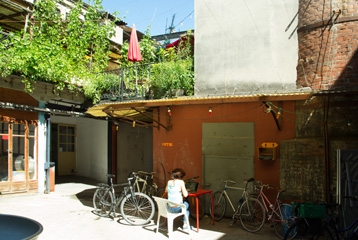A suburb used first for military then for market gardening purposes, Plainpalais became an area where people would come to relax in the 17th century before the countryside gradually gave way to urban development. The agricultural area of la Jonction, on the other hand, became an industrial hub in the 20th century.
A district born from the conquest of the River Arve
A muddy delta for gold washers
For a long time, the land between the Rhône and the Arve was nothing more than a muddy delta. The only visitors were gold washers who came looking for gold in the Arve. The history of the Plainpalais Jonction district was first and foremost a conquest of this river, which would often burst is banks. As early as the 13th century, the locals attempted to contain the Arve in order to make use of the plain and the land of la Jonction area.
A wasteland scattered with ruins
In 1531, with the threat of the Savoyards looming large, the people of Geneva decided to raze all the city’s suburbs to prevent the enemy from advancing unseen. The population withdrew within the city walls and the stones from the destroyed houses were used to strengthen the ramparts. Plainpalais became a no man’s land, scattered with ruins. In 1536, the Republic of Geneva was proclaimed. But Geneva remained a citadel and Plainpalais a wasteland, even after the peace treaty signed in the wake of l’Escalade.
Revival of the Plainpalais suburb and agriculture in la Jonction
The district owes its revival to the Duke of Rohan. While staying in Geneva in 1637, the Duke suggested transforming the plain into a promenade planted with lime and elm trees while laying out areas to play jeu de mail, a very fashionable game at that time. The plain became the beating heart of the Plainpalais district, with its games of “mail”, its military exercises and its fairs.
In la Jonction, the land reclaimed from the waters was earmarked for agricultural purposes.
The “Garden of Geneva”
Having conquered the waters of the River Arve, the Plainpalais Jonction area proved highly conducive to agriculture. And so the peninsula of la Jonction earned its sobriquet of “Garden of Geneva”. Incidentally, the market gardeners were referred to as “plantaporrêts”, a deformation of “planteurs de poireaux”, or leak planters. Along the boulevard Saint-Georges, some street names bear testimony to this past such as the rue Jardins, rue des Plantaporrêts and, further on, the rue des Maraîchers. The rue de la Puiserande refers to a wheel which draws water using the strength of a horse.
Towards Plainpalais, gardens and houses also began appearing between the Rhône and the Arve, despite the latter's tendency to flood. In the 17th century, the gardens were primarily tended by French refugees who introduced the people of Geneva to vegetables hitherto unknown to them, such as purple artichokes and cardoons, which became a labelled speciality of Geneva.
Urbanisation and industrialisation of the district
In the 19th century, the municipality of Plainpalais was still rural. Its unpaved main street, rue de Carouge, was lined with small houses surrounded by gardens. It nevertheless gradually developed and became more urbanised. A school was opened along with shops, public services such as a hospital, cultural sites (theatre, casino-theatre, diorama, etc.) and universities, with the chemistry and medical schools.
Over the centuries, the Plainpalais plain became a central location for popular festivities. The site that hosted part of the National Exhibition of 1896 is now the site of annual National Day festivities and has also hosted the famous flea market since 1970.
The suburb of la Jonction remained rural until the beginning of the 20th century. In 1850, work was carried out to raise the land to protect it from flooding. Little by little the gardens gave way to factories. The suburb became an industrial hub, with most of the factories now converted into cultural centres.
What do “Plainpalais” and “Jonction” mean?
The name “Plainpalais” probably comes from the Latin expression “plana palus”, meaning “marshy plain”. The area between the Rhône and the Arve, at the foot of the hill overlooking Geneva, was stony and very often covered by the waters of the Arve.
La “Jonction” takes its name from the place where the Arve joins the Rhône. This confluence can be observed from the CFF railway and pedestrian viaduct in la Jonction, accessible via the Sentier des Saules. The green waters of the Rhône, cleaned after flowing through the lake, gradually mix with the muddy brown waters of the Arve.
Sources:
- Pierre Bertrand, Plainpalais, son passé, son avenir, Geneva, 1943
- Historical dictionary of Switzerland, "Plainpalais" article, 1998-2013
Article modifié le 25.09.2020 à 17:05

